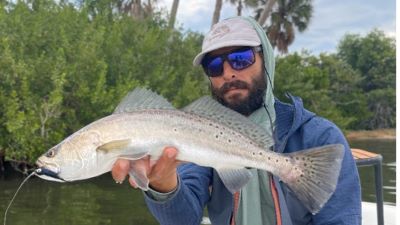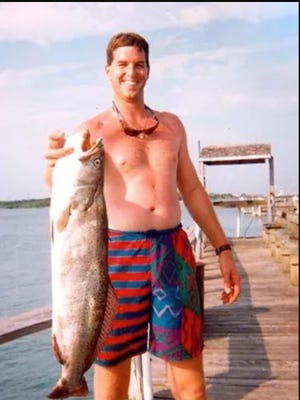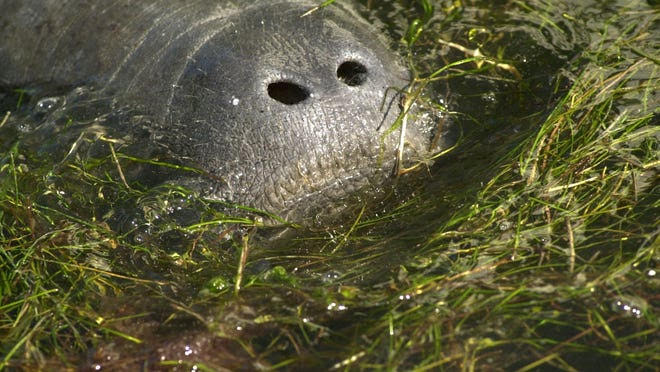by: Timothy O'hara, courtesy of TC Palm
The Treasure and Space coasts were once the spotted sea trout fishing capital of the world, but years of poor water quality and seagrass die-offs have stripped those coasts and Florida of the title.
Craig Carson's nearly 18-pound, 39.5-inch sea trout caught in Fort Pierce in 1995 still stands as the International Game Fish Association world record. A catch even close to that is impossible in the Indian River Lagoon because of seagrass and water quality degradation and more anglers targeting a much smaller population of fish than 35 years ago.
To beef up the stock, several lagoon fishing guides have asked the Florida Fish and Wildlife Conservation Commission to make sea trout in the lagoon catch-and-release only, like redfish is. Since the redfish rule change three years ago, anglers are seeing more and larger redfish, according to fishing guides Noah Miller and Thomas DiMatteo.

"On a jig or a fly, you could catch a handful of big ones without batting an eye," Miller told TCPalm. "There was so many that it was frustrating to get through to get to a snook or a redfish.
"Now, guides are calling each other to let each other know where they are. It boggles my mind that they are not closed to harvest, like redfish. Ten to 12 years ago ... if you wanted to catch a trophy seatrout, you came here. Now you would be lucky to catch a trophy fish three times a year. It is a unicorn. Th e number of trout are falling off so quickly."
e number of trout are falling off so quickly."
States such as Texas offer much better sea trout fishing, the guides said.
Miller blamed a 2010 freeze, 2016 algae blooms and fish kills, and Lake Okeechobee discharges. "Habitat loss, primarily seagrass due to a lack of water quality, is without a doubt the leading cause of the problem," he said.
Sea trout is an indicator species of the overall health of the lagoon and its seagrass meadows.
"The lagoon is not doing well," Miller said. There is currently "zero truly clean water in any part of the lagoon."
Some Florida anglers support catch-and-release for spotted sea trout
Poor water quality will kill what little seagrasses remain and "no grass means no trout," Miller said.
"Without seagrass, a huge concern is that the small sea trout that remain, which rely on grass as cover and protection, will not grow up to become the trophy fish that used to bring millions of dollars in revenue to this state through anglers looking to catch the sea trout of a lifetime," he said.
Sea trout are vulnerable targets of people, dolphins and other predators. They live in seagrass rather than hide in the mangroves. They are not tough and can die from being mishandled, Miller and DiMatteo said.
Seatrout isn't sought-after table fare, so catch-and-release wouldn't rob people of food, DiMatteo added.
"I am just trying to think logically about this," DiMatteo said. "This would not be a huge deterrent for fishing guides."

Commercial harvest of sea trout in Indian River Lagoon
There are only three commercial fishers who regularly target sea trout, far fewer than 35-40 years ago, so there is much less pressure on the fishery, said Sebastian commercial fisher Tim Adams.
Adams wants FWC to continue allowing commercial harvest of at least 50 fish per fisher per day, but he said he would be willing to stop fishing in May, which is the peak of the April-to-June spawn. FWC also allows 100 fish per boat per day if there are two of more anglers, with saltwater product licenses, on the boat.
Recreational anglers currently can keep two sea trout, with one being larger than 19 inches.
The FWC board in November proposed rule changes and new management regions, plus Chair Rodney Barreto asked the staff to research the catch-and-release idea.
"I think's that appropriate," he said. "Lets vet it out. We have time to adjust this."
Please consider becoming an AAF member. All text and images in this article appear courtesy of Timothy O'hara and TC Palm- please visit them at https://www.tcpalm.com/ to read more from Tim and many of their other incredible staff.
